Erick Conard's Lucky Hit Ranch: Anatolian Shepherd Page

The Genetic Difference Between
Anatolians and Kangals

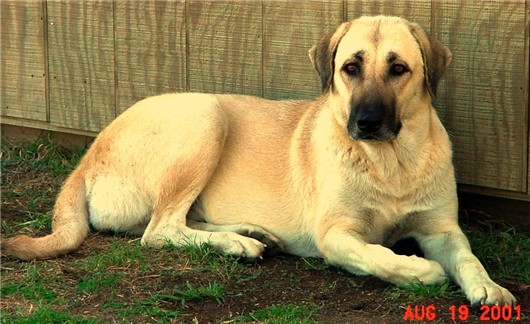 Shadow - Kangal or Anatolian?
Shadow - Kangal or Anatolian?
 Click picture below for
Click picture below for
Erick Conard's Address, Email, and Phone Number Information
in a New Window
Erick's Address, Email,
 and Phone Numbers Link
and Phone Numbers Link

I was asked, "What's the genetic difference between a 'Kangal,' a fawn
Anatolian with a black mask, maskless Anatolians, and those Anatolians whose
bodies are grey, red, pinto, or white in color." The short answer is -- there isn't much
difference at all ... basically only a variation in the less well understood
color modifiers for the "A" Locus and, on Anatolians with white spots (pintos), the
presence of the spotting gene at the "S" Locus.
"Dun" or Fawn with a black mask
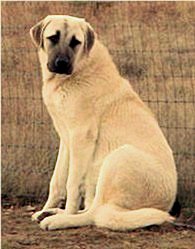
The Anatolians that are dun (fawn) with a black mask carry the "Ay," or sable, gene at the
"A" Locus (Agouti Locus). Genes at the "A" Locus code for a signaling protein, the
Agouti Protein (AP). AP's job is to counteract the effects of the Melanocyte
Stimulating Hormone (MSH) (which tells the melanocytes to produce black) on the
MC1-R receptors located on melanocytes. The signaling protein (AP) stops eumelanin
(black pigment) production, which would otherwise be present.
Phaeomelanin is apparently the "default" pigment. In other words, without other
gene directed enzymatic and regulatory activity, a dog's coat will become some
shade of yellow. Since the AP stopped eumelanin production (black), the "default"
yellow-red phaeomelanin pigment is produced. Pigment modifying factors can result
in yellow phaeomelanin shades anywhere from light cream to dark red color
variants. Other Ay (sable) modifiers can add from a small amount of black tipping
on the longer coarser hairs to a great deal of black sable covering much of the
dog's coat. Using the wide range of variation possible for "Ay" alleles, an
Anatolians coat can vary from pale beige to gray, dun, yellow, or even what appears
to be white at first glance.
In the "Kangal," it appears that breeders are attempting to narrow the potential
variety of the Ay (sable) gene by selecting only for the "dun" color modifiers you
mentioned and by eliminating the spotting gene. Basically, it seems to me that
Kangals are being selected for a color range that is narrower than is allowed in
the Anatolian Shepherd. I believe that these dogs, both the so called "Kangal" and
the Anatolian Shepherd, have been historically bred for their superior guardian
ability rather than for color. To me, giving a subgroup of dogs a breed
designation as a result of narrowing the color genetics in a working guardian
landrace seems purely artificial. I believe that giving breed designation to
Anatolians without a black mask would be just as scientifically incorrect as
giving breed designation to Anatolians without white and calling them Kangals.
. Ay - The Sable allele produces fawn with variable amounts of black.
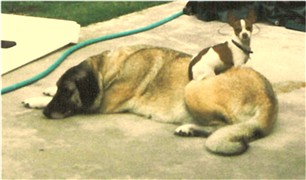
In Anatolians, the almost universally found allele of the "A" series is the sable
allele, Ay. The Ay allele produces fawn colored dogs and, depending on other
genetic color factors, can result in a dog anywhere in a color range from a pale
biscuit through shades of yellow to a rich red. The Ay allele also directs the
production of some black hairs, which are sometimes identified as "sailing." These
Ay produced black hairs are generally denser on the dog's dorsal surface and absent
or very sparse on the dogs ventral surface. The Ay allele also permits the
expression of a gene for black mask and ears and a gene for brindle. (The
locations of the mask and the brindle genes are uncertain at this time and several
possible locations have been explored.)
The expression of the Ay (sable) allele results in a fawn colored dog (from
phaeomelanin (yellow-red) color pigment since eumelanin (black) was inhibited).
Fawn (or sable) dogs have amounts of black colored hair in their coats that can
vary greatly from very few black hairs to much of the hair in the coat being
black. Black hair on a sable dog can range from the individual hair being solid
black to the individual hair being black only at the tip of the hair. Also, in
sable dogs, both black and yellow pigment is found in the same hair. Even if it
appears a dog's coat is without black, a sable (Ay) dog's whiskers (the stiff
vibrissae) growing from pigmented skin are black.
Alleles found on the A Locus are the Sable gene, the Wolf (wild) gene, Black and Tan,
and Recessive Black, listed with the most dominant first. The Sable gene and
the wolf gene give a similar overall appearance. Since they are dominant in
expression to the Black and Tan and Recessive Black, these recessive colors are rarely seen. However,
Natalka Czartoryska documented these recessive colors in Turkish guardians in pictures she
took in the 1960's or 1970's which are found the the Natalka Czartoryska Collection.
I am thankful that the Standard was created by individuals who understood that
Anatolians are a "landrace" that varies in appearance as you travel across Turkey.
The unifying factor in this breed is SUPERIOR WORKING ABILITY GUARDING SHEEP AND/OR
GOATS IN A PREDATOR RICH ENVIORNMENT and not somethings as irrelevant as color,
which has nothing to do with working ability!!!
Effect of the "S" Locus... the Spotting Gene
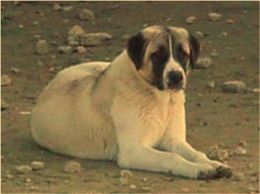
Some genes affect the migratory pathways of the neural crest cells which ultimately
form melanocytes (the cells that produce pigment). Both Spotting (S) and Merle (M)
are produced by genes that affect the migratory pathways of melanocytes. The
Spotting gene ("S" Locus), which is found in Anatolians, affects the amount and
location of unpigmented (white) areas on the dog. The following allelic
assignments are made in descending order of dominance.
. S - Self ; Produces complete pigmentation. This is the normal, no-spotting gene
and is dominant.
. si - Irish spotting (sometimes called Dutch marking in Anatolian Shepherds);
Irish spotting creates a white collar and blaze with some white on the belly, legs
and chest. This allele may be additive as it is thought that dogs homozygous for
Irish spotting have irregular white patches on their bodies, with the number and
size of these patches being extremely variable.
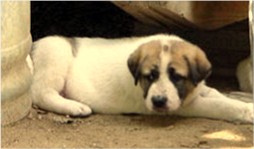
. sp - Piebald spotting; codes for colored patches on a white background. The
piebald allele results in well defined areas of colored and white hair.
. sw - Extreme White Piebald; creates a few small colored spots on a white
background. It also may produce all white animals in some breeds.
Robison created a scale to help clarify the type of spotting a dog has. This scale
shows a color gradient ranging from solid to almost pure white. Therefore, rather
than four specific alleles which code for four different outcomes, it is possible
that the expression of the spotting gene may instead be controlled by additive
modifiers.
I have completed a more comprehensive explanation of dog coat color genetics with an
emphasis on the Anatolian Shepherd which is included in my web site at
http://www.luckyhit.net/coatcolo.htm.
 Click Picture to Return to Anatolian Main page
Click Picture to Return to Anatolian Main page

 and Phone Numbers Link
and Phone Numbers Link

 and Phone Numbers Link
and Phone Numbers Link




 Click Picture to Return to Anatolian Main page
Click Picture to Return to Anatolian Main page